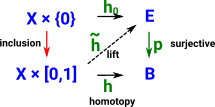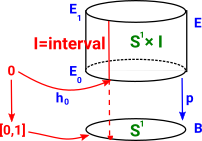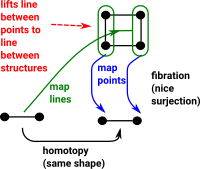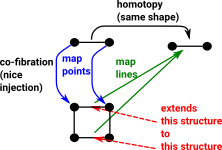Introduction
This page continues from the model category page which is introduced on the page here.
Fibrations have additional structure to fiber bundles (see the page about fiber bundles here) which allows some structure in B to be 'lifted' to E. (see Wikipedia page).
Fibration and Co-fibration
Homotopy has the concept of:
- a fibration which has the lifting property.
- a co-fibration which has the extension property -extension is dual to lift.
Fibration |
Co-fibration (Extension Property) |
|
|---|---|---|
| Homotopy | Fibration |
Co-fibration (see page here) |
Combinatorics |
Kan fibration (see page here) |
Kan extension (see page here) |
Kan fibrations are combinatorial analogs of Serre fibrations of topological spaces.
Lifting Property in Topology
This fibration is like a fibre bundle in sets, the differences are:
That is: the fibration goes from E to B (the vertices map in that direction) but the open sets map in the other direction so if we first map each point to an open set containing only that point we can then map to E. So composing these arrows gives 'lift'. |
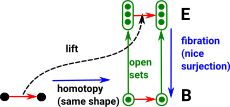 |
For more about the lifting property see the page here.
Fibration - Line to Point Map Example
| To keep things simple, take the example of a line continuously retracted down to a point. |  |
 |
To see this, in its most general form, as a continuous map between topological spaces I have drawn the line consisting of representative points and open sets. |
For it to be a continuous map the preimage of an open set must be an open set. We don't want to have to make any arbitrary decisions about which open set to map back to, so the preimage is the open set around the whole line. |
 The red arrow is a map between open sets. |
This is the homotopy lifting property. When we look at more complicated examples (see fibration page) we will see structure between points being lifted to structure between open sets.
Fibrations and Indexing
In sets we can look at fibrations as an 'I' indexed family of sets. To denote this I have replaced B with the indexing set 'I' and replaced E with the family of sets X, like this: ![]() In the slice category of sets:
In the slice category of sets:
| These are the objects | |
| These are the arrows |
That is, in the slice category the indexing set remains the same.
Here are some examples of comma categories. In these cases all the objects are in the same category (including the fixed object). The comma category generalises this by allowing the objects to come from other categories.
Arrow categorysee page here |
 |
|
Examples |
Slice categorysee page here |
 |
|
|
Co-slice categorysee page here |
 |
|
Examples |
Fibrations and Substitutions
Fibrations and Lifting
Given a path [0,1] in the base space B and a point e0 in the total space E. We can 'lift' this path into the total space E as a path starting at e0. |
 |
Here I am mostly concentrating on discrete structures so we need a looser concept of continuous mappings. |
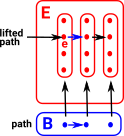 |
An inclusion from [0,1] into B can be lifted into E: If we are using CW-complexes to model our topological spaces then we can use a slightly weaker form of fibration known as a Serre fibration. |
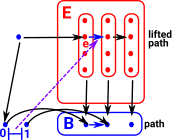 |
Simple ExampleFibration and co-fibration is related to fibre bundles as discussed on the page here. To recap from this page we can start with a surjective mapping between sets and then add extra structure to these sets. In this example we have two sets B the base set and E the total set and a surjective mapping p between them. |
 |
| We get a fibre bundle by trying to get as close as we can to the inverse of the function p without making arbitrary choices. |  |
On this page want to expand the idea of fibre bundles on sets to add more structure. As an example lets go from sets to directed graphs. The function p must now map the arrows as well as the vertices. |
 |
What is the closest we can get to an inverse function? Here is a possibility. This 'lifts' the vertices to sets which may contain multiple vertices. |
 |
Is this valid because two paths join and this is like a tear which is not allowed in topology/homotopy transforms? |
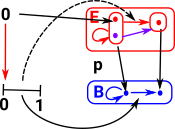 |
So E is like a product. Here we lift the interval to the red arrow in E. note: we think of this as being continuous even though this example has discrete vertices. |
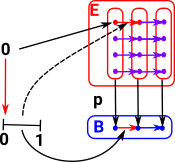 |
But E only needs to be like a product locally. |
 |
Can we think of this lifted mapping as being between the sets? |
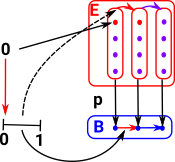 |
Fibrations of Graphs
theory: topological graph theory
| undirected graph: | covering projection |
| directed graph: | fibration (weaker form of covering projection) |
Here is an example for directed multigraphs. Each node in the top graph maps to the bottom graph (fibration). The corresponding node always has the same number and colour of incoming arcs (but not necessarily outgoing arcs). This gives some sort of local invariance. |
 |
Fibration and Co-fibration
Homotopy has the concept of:
- a fibration which has the lifting property.
- a co-fibration which has the extension property -extension is dual to lift.
Fibration |
Co-fibration (Extension Property) |
|
|---|---|---|
| Homotopy | Fibration |
Co-fibration (see page here) |
Combinatorics |
Kan fibration (see page here) |
Kan extension (see page here) |
Kan fibrations are combinatorial analogs of Serre fibrations of topological spaces.
Next
If we reverse the arrows in the diagram for fibrations we get the diagram for cofobrations:
Co-fibration involves the concept of extension
- fibration - lift
- co-fibration - extension
Extension is dual to lift.
- Fibrations and Cofibrations are used in model theory.








